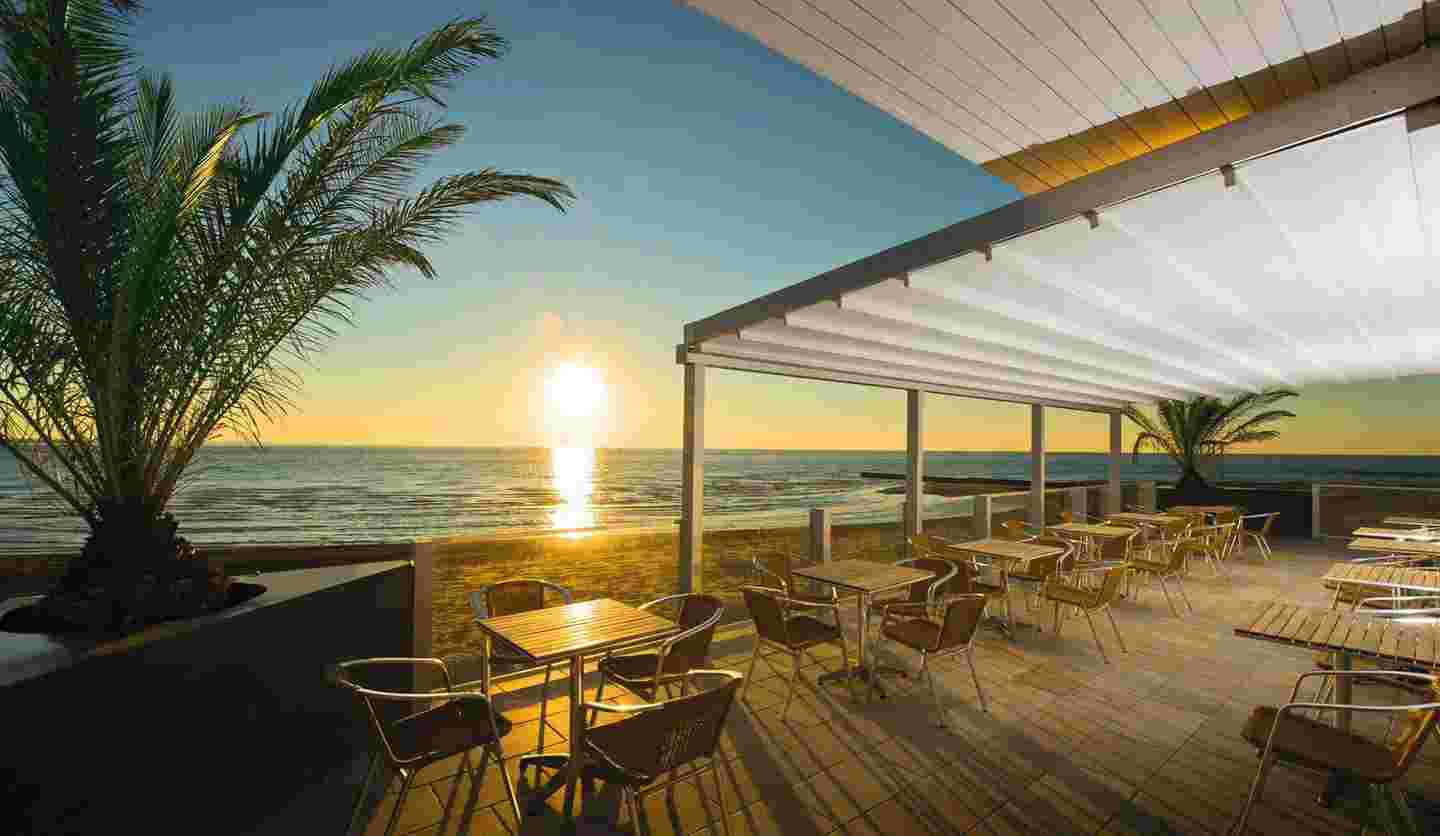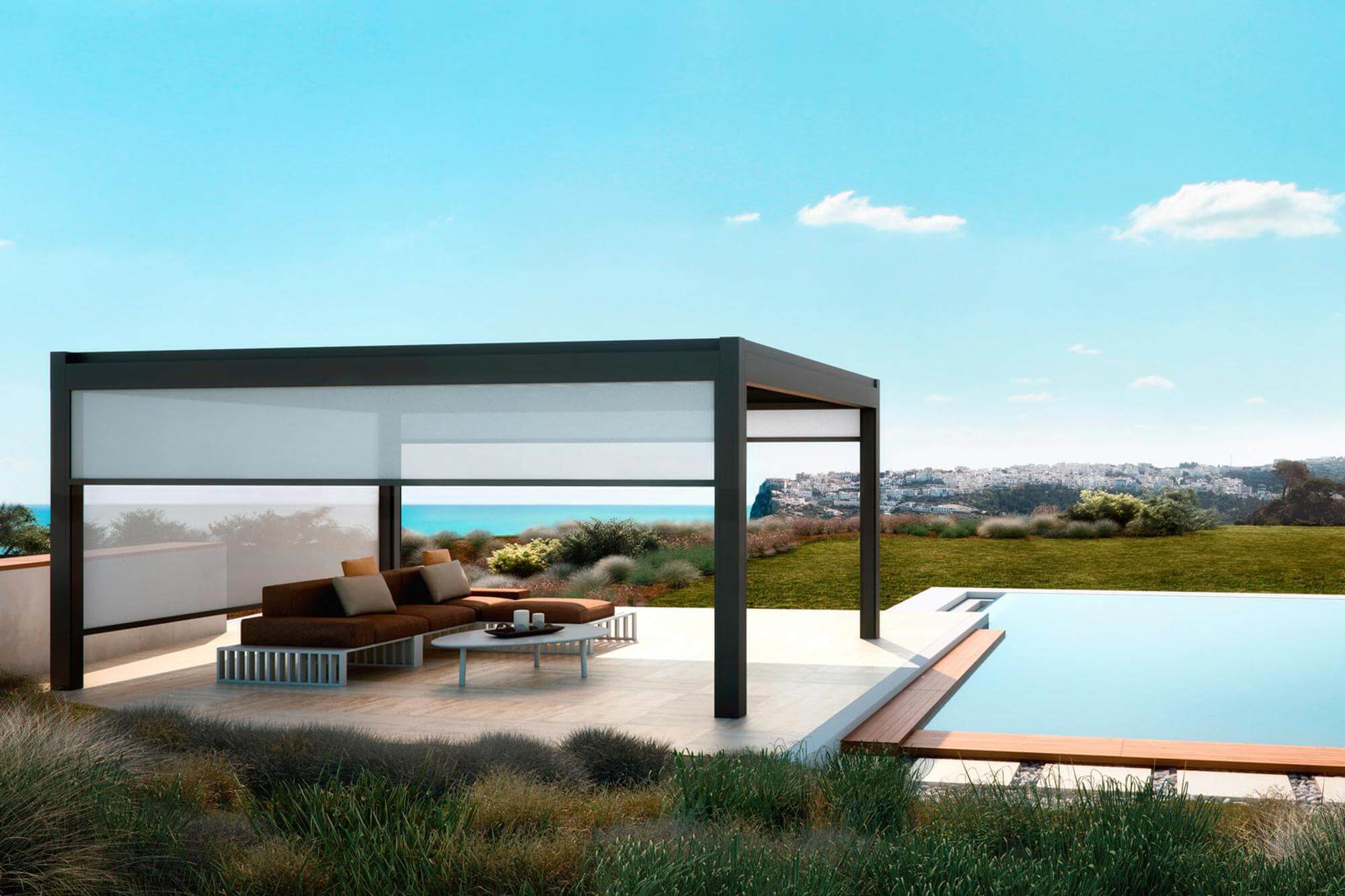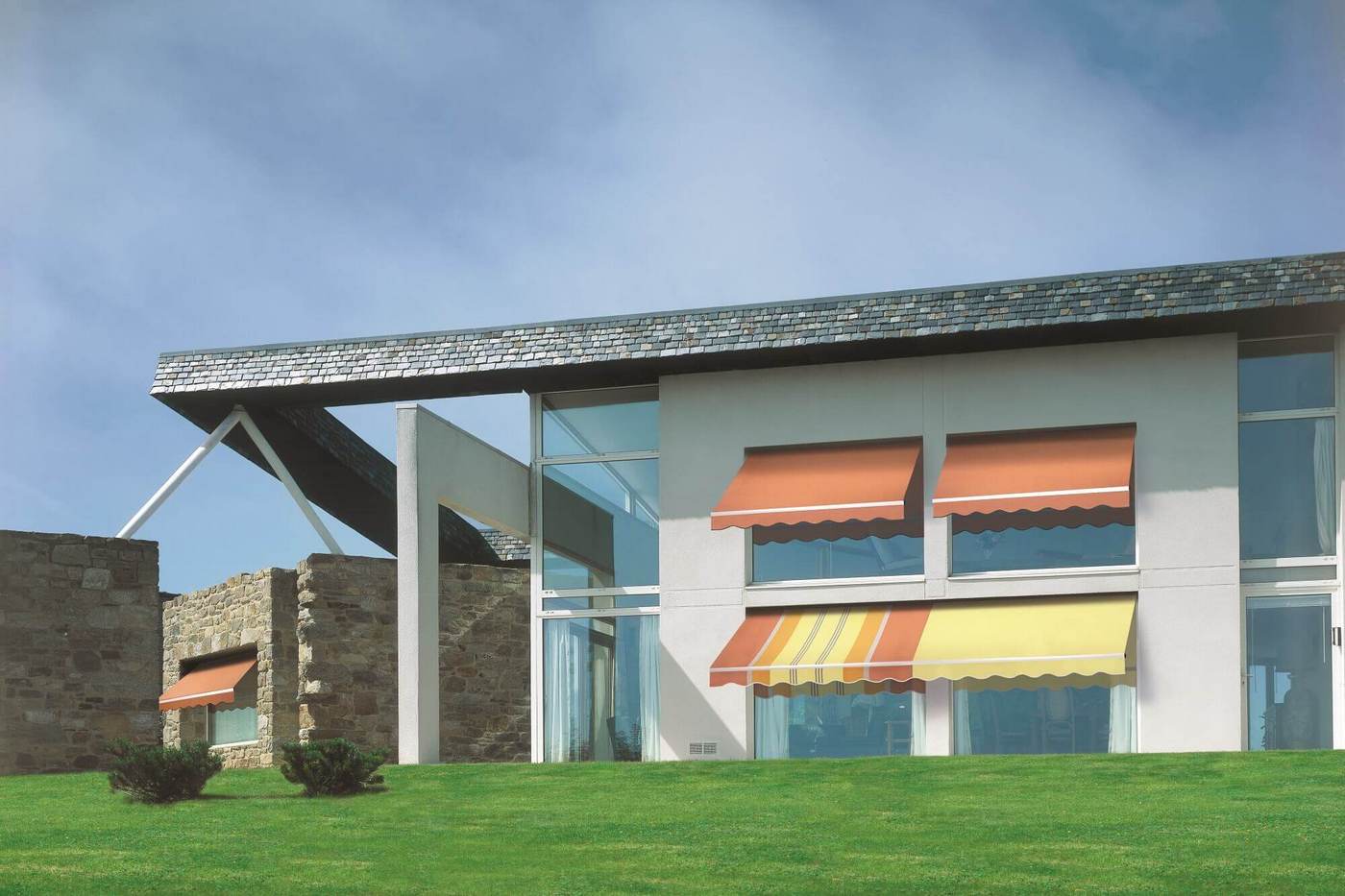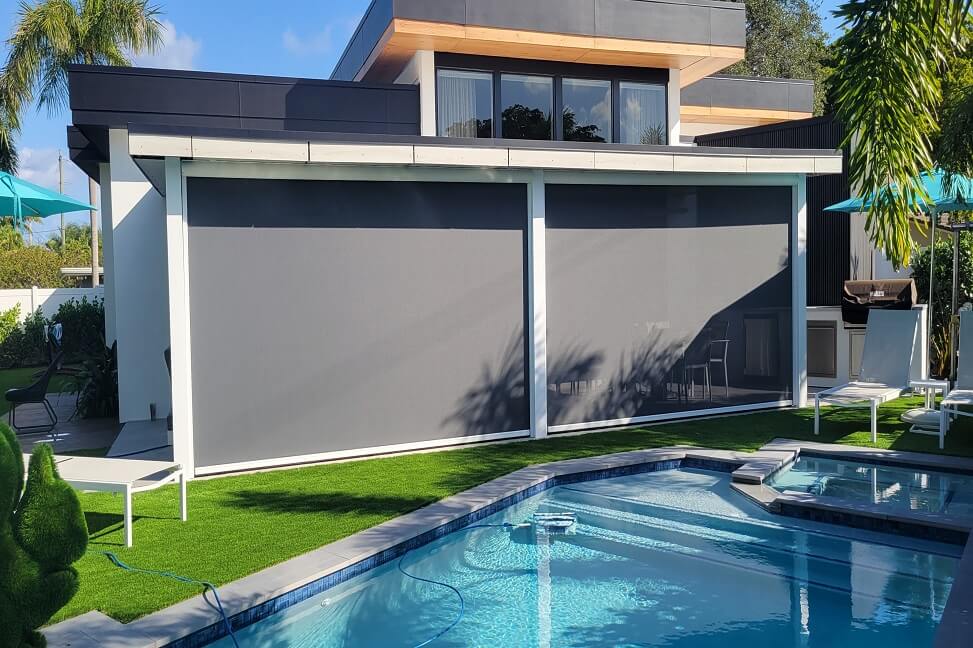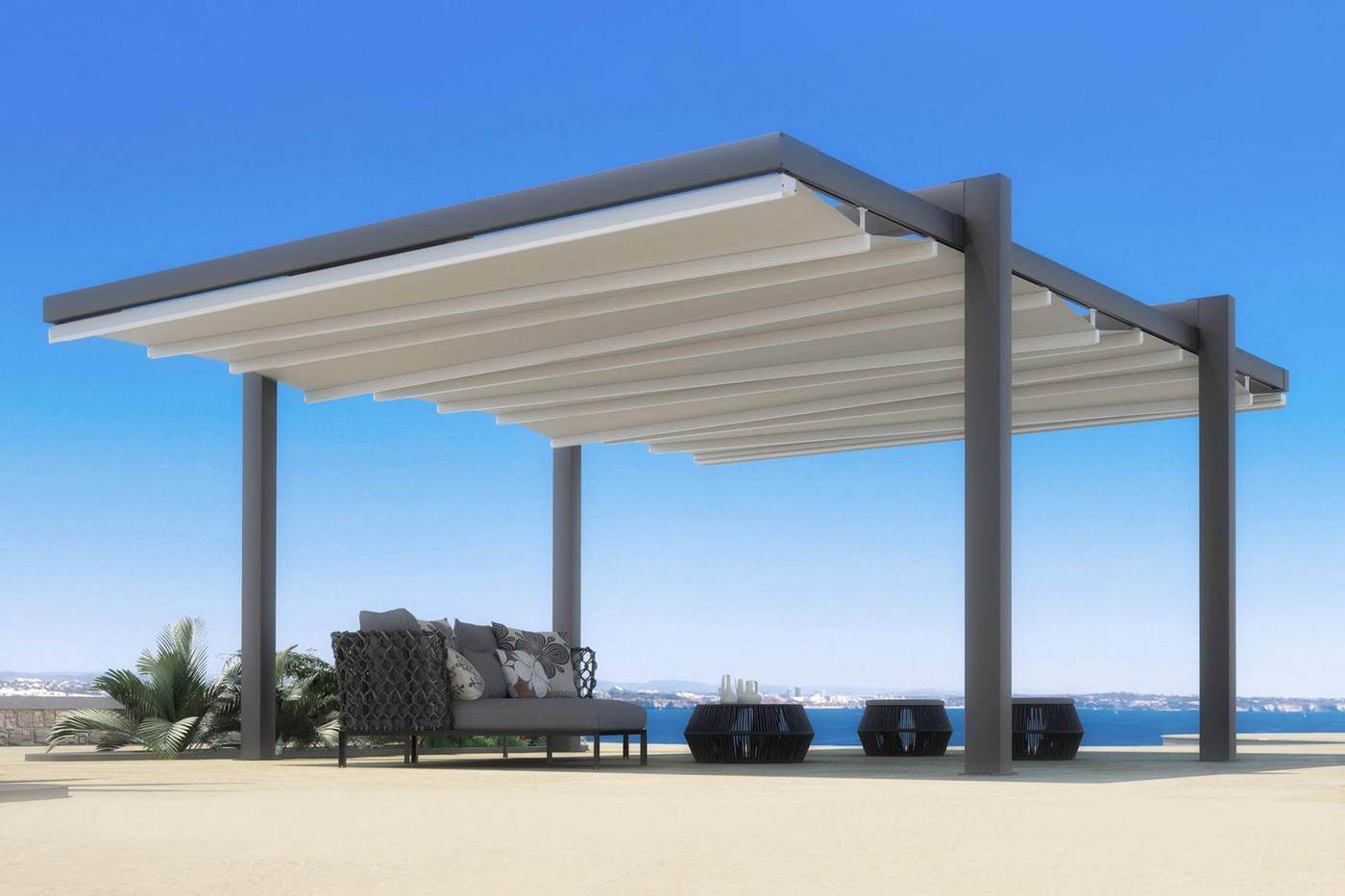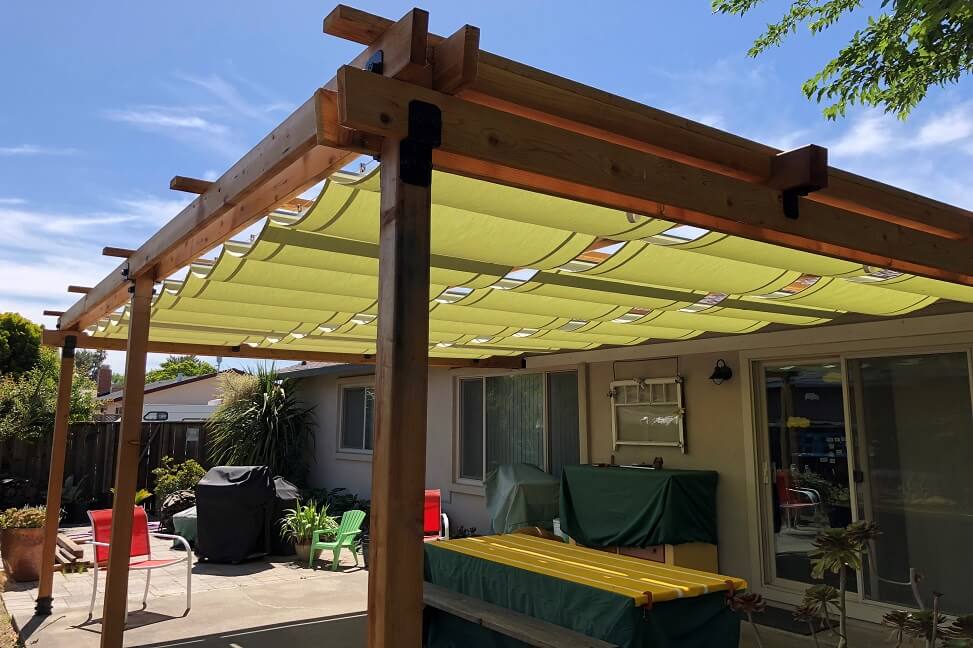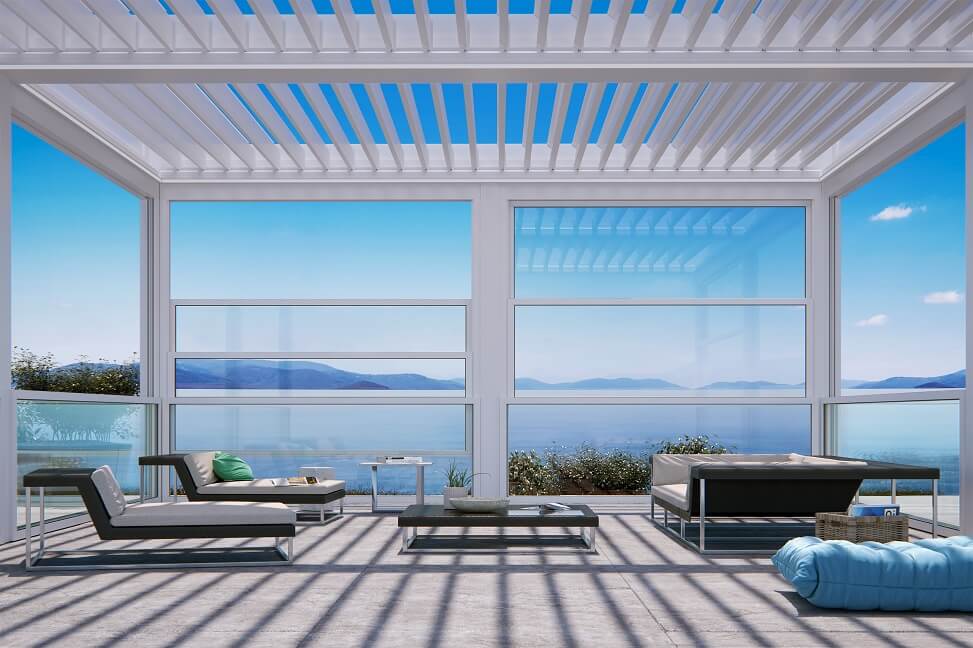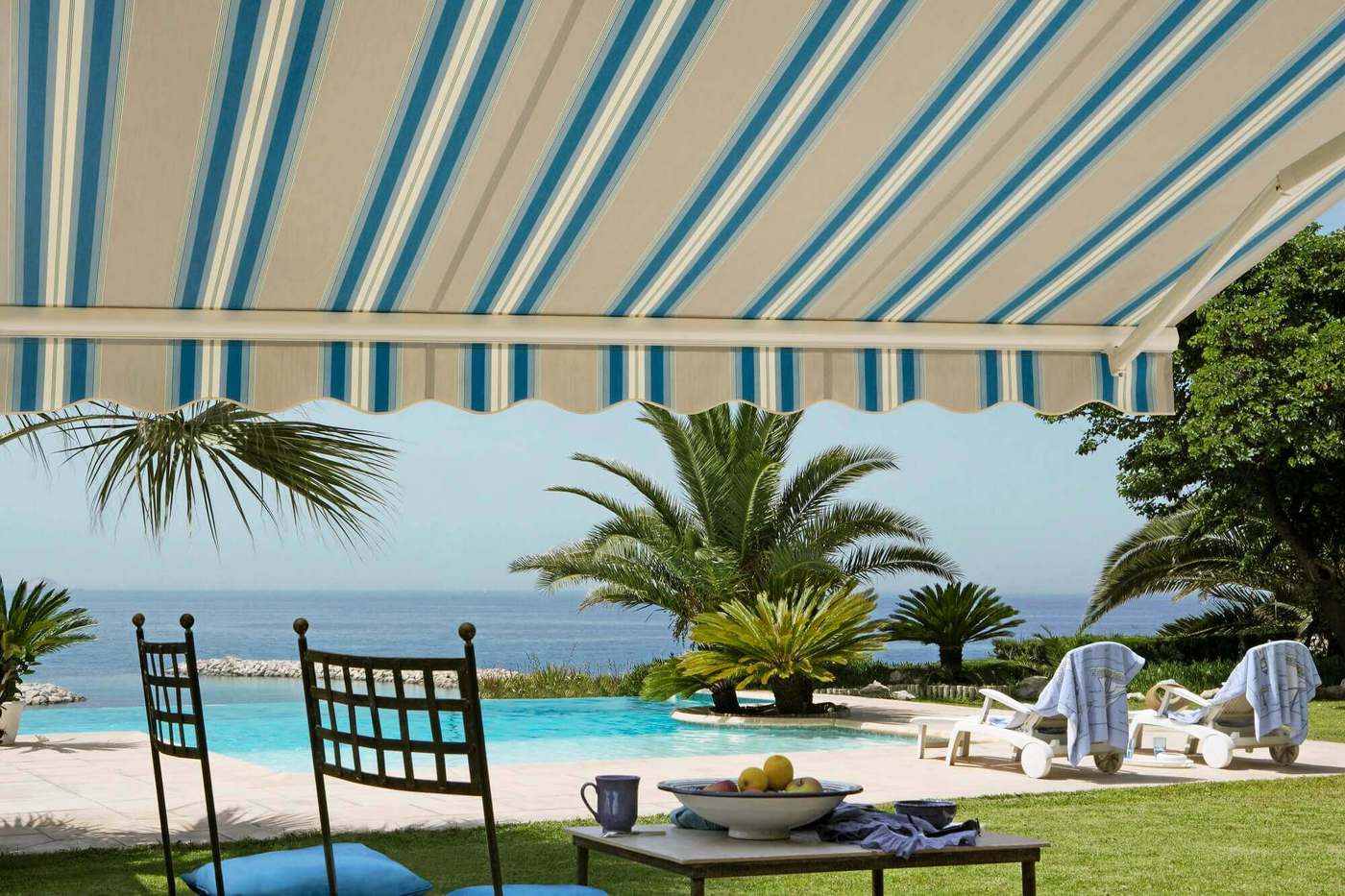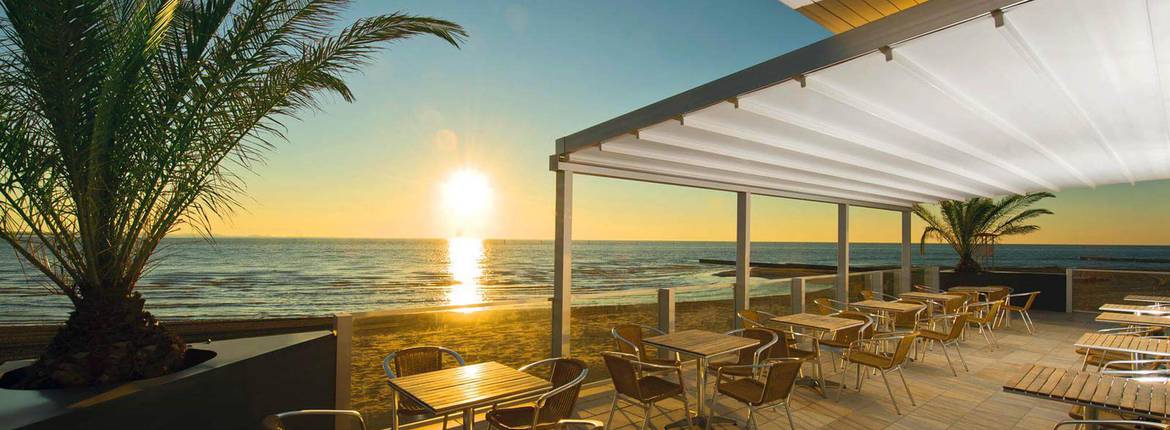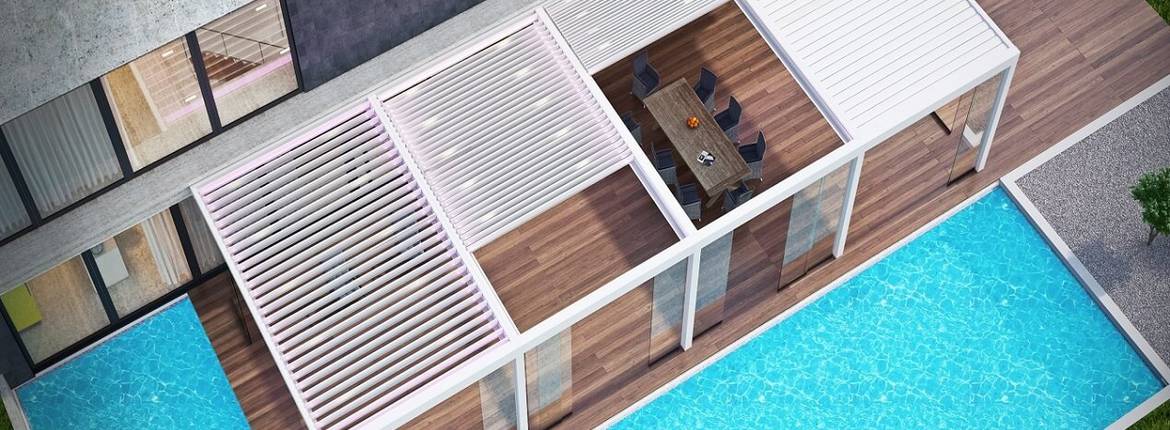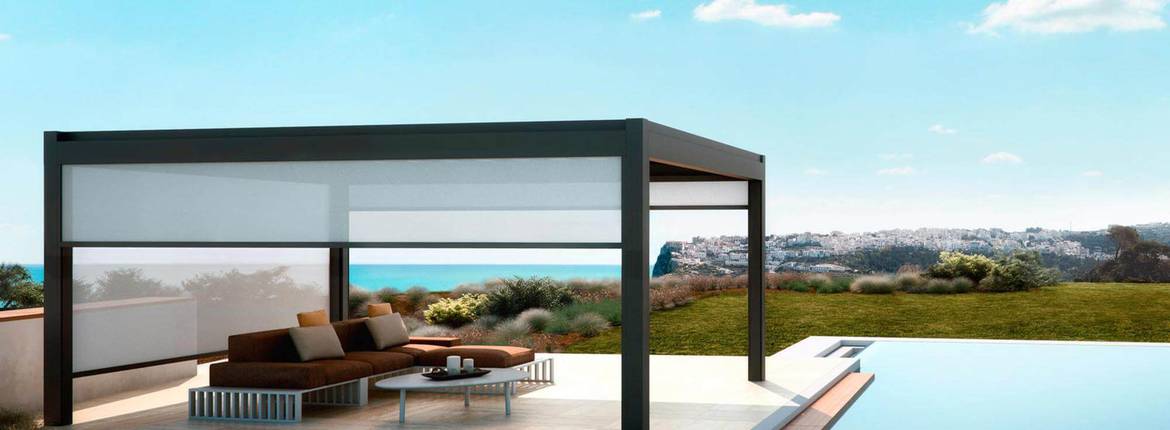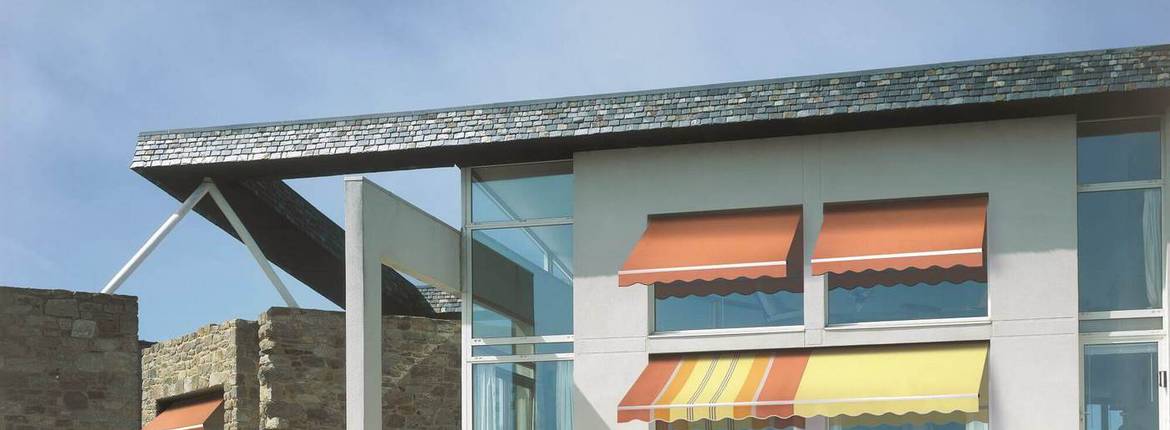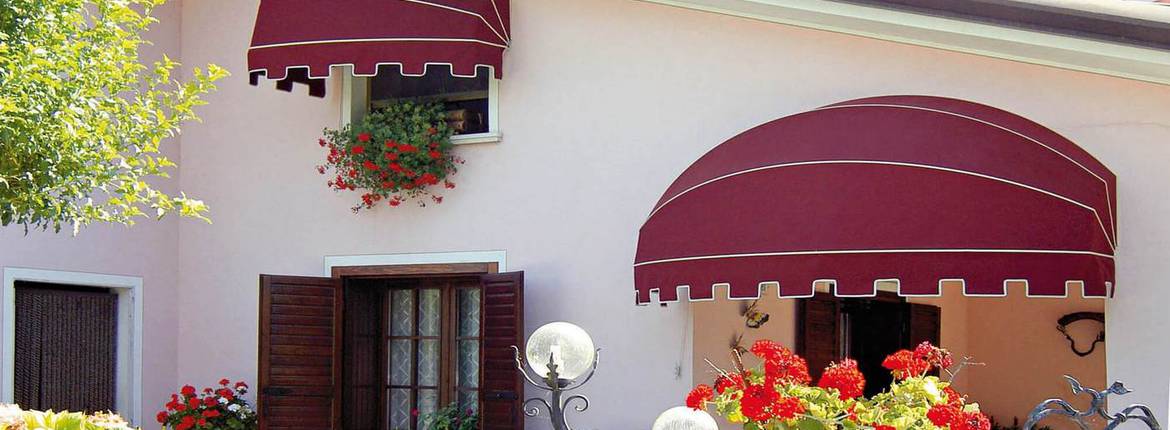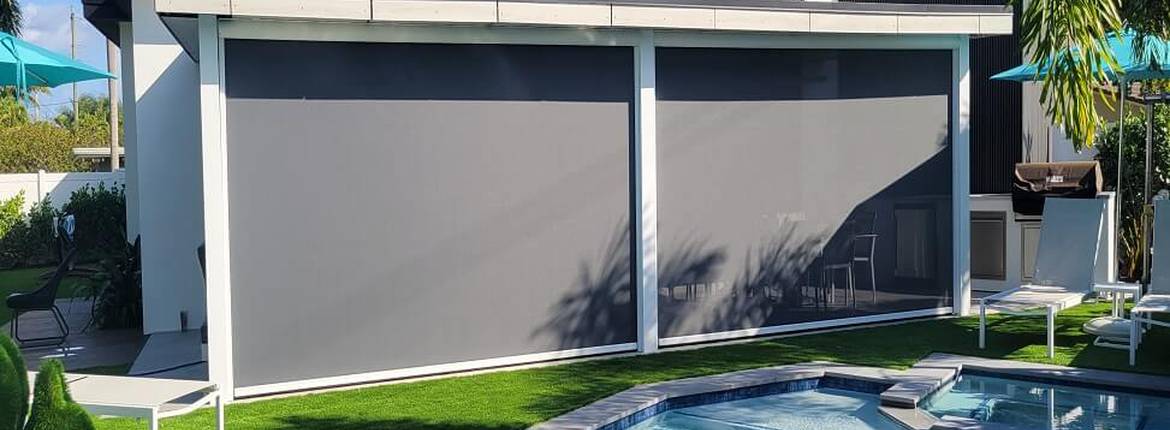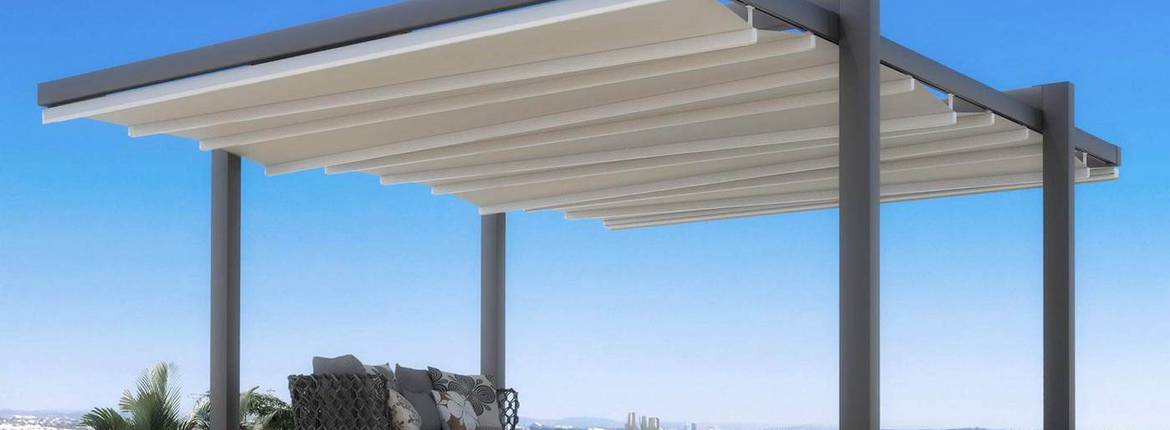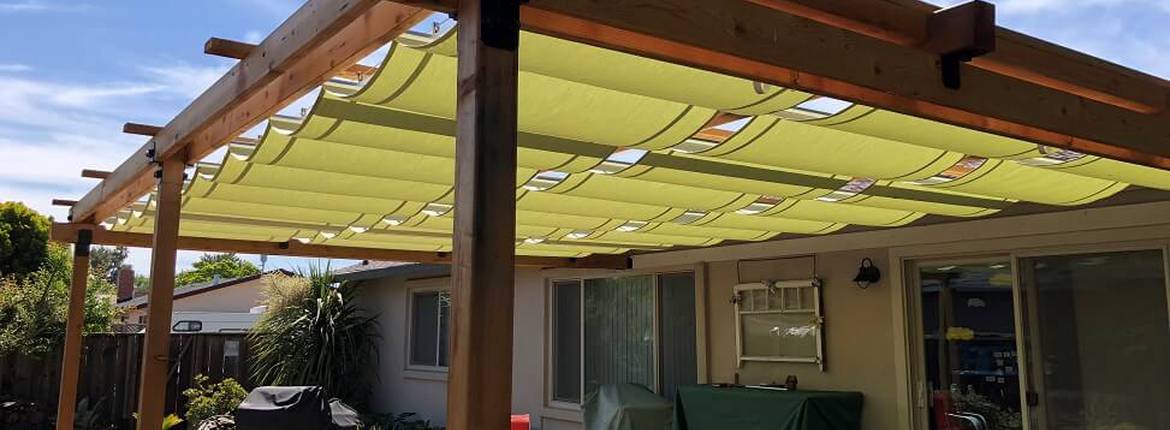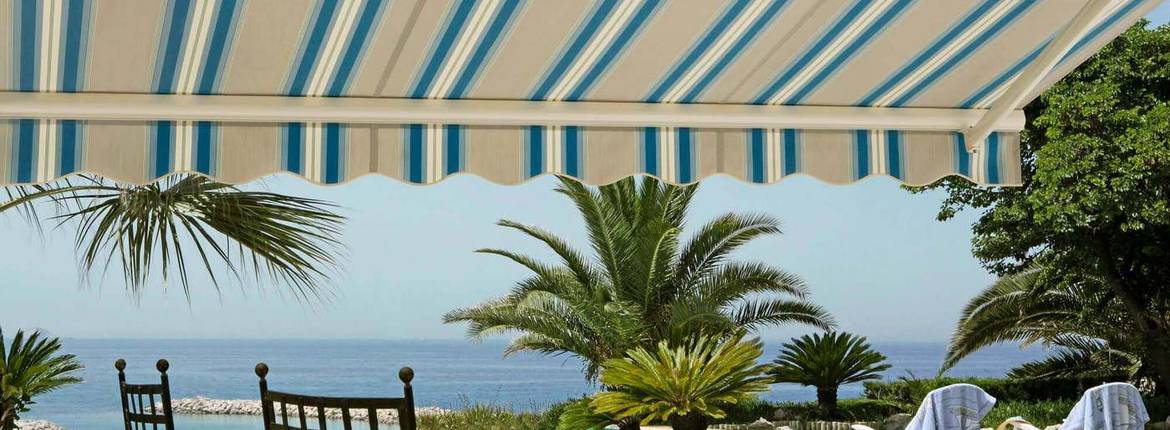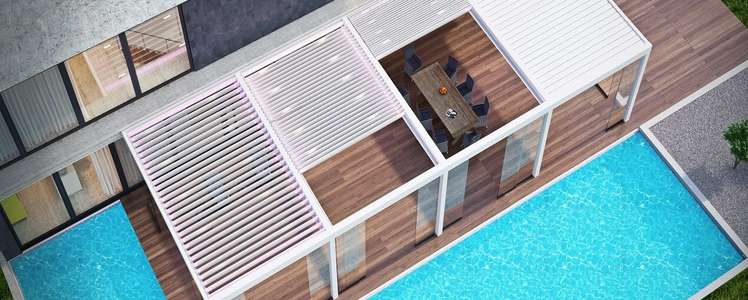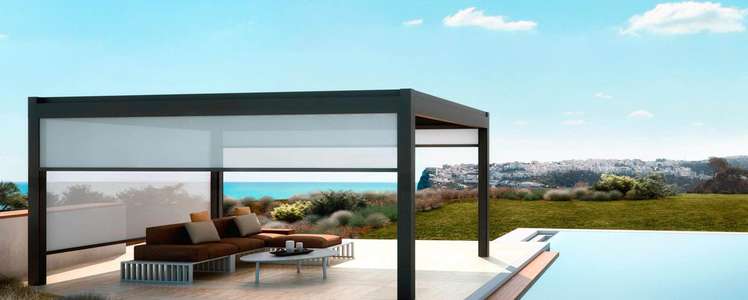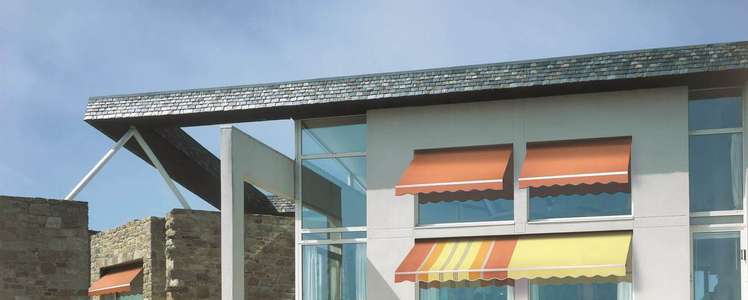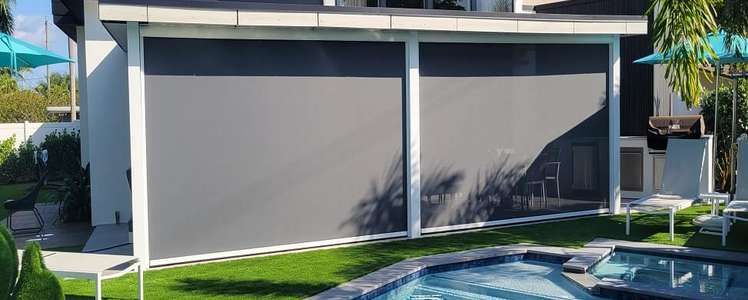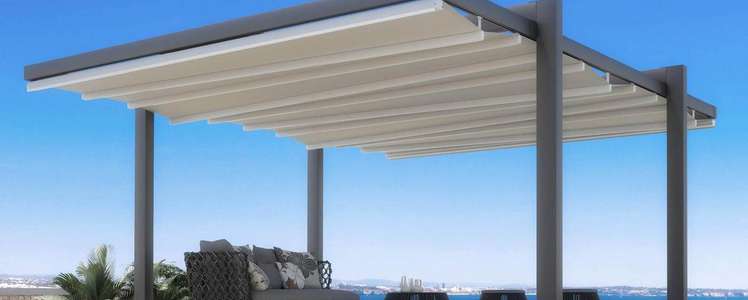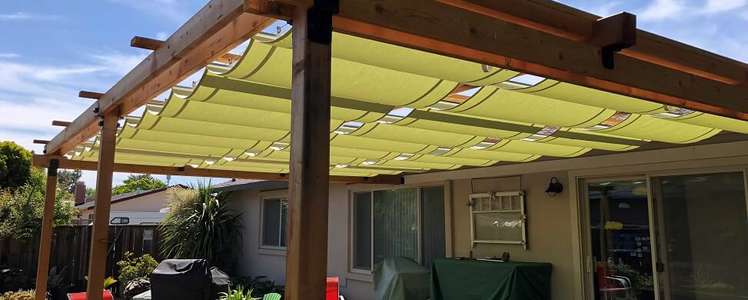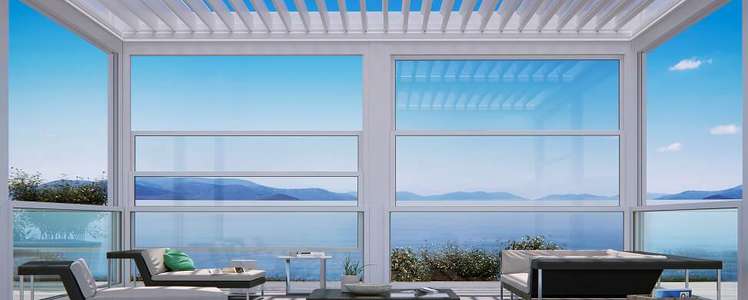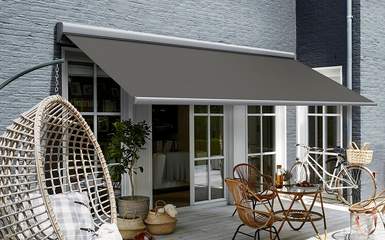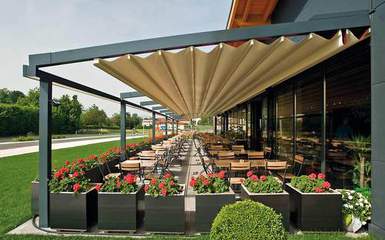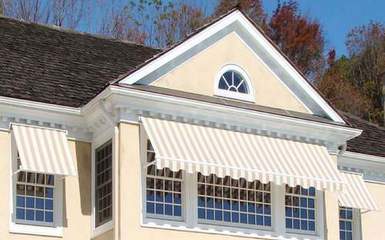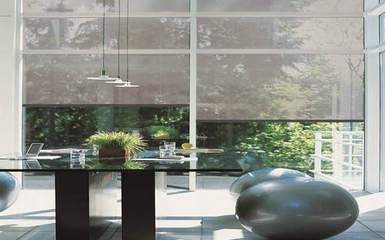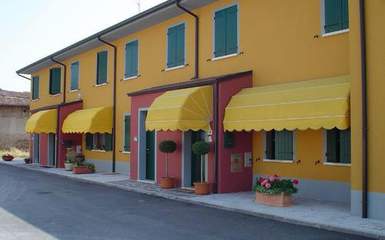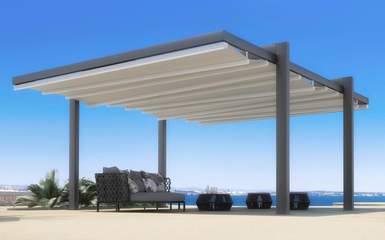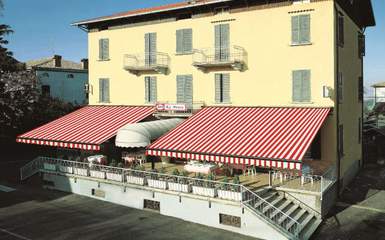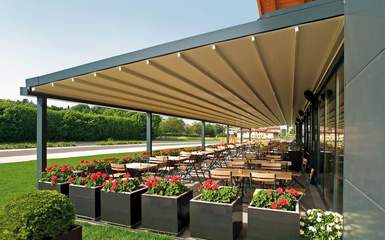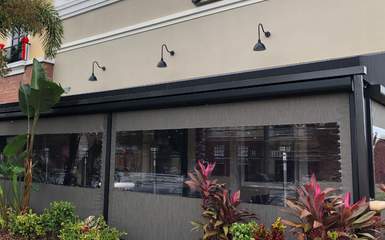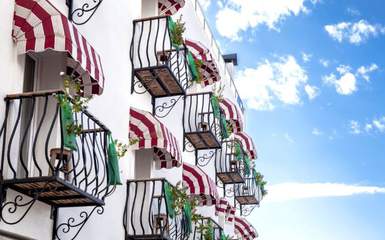The major difference between a non-retractable product vs. a retractable product comes down to one word: movement.
As the names imply, a permanent, stationary or fixed cover cannot move, and it cannot open and close, while a retractable cover can. Retractable shade canopies, retractable fabric roofs, retractable louvered roofs, and other kinds of covers can be closed, partially opened, or fully opened using a manual or a motorized control. This makes retractable products far more flexible, and this flexibility translates into some significant performance benefits.
Longer Lifespan With The Fabrics
One of the most vulnerable elements in an awning is its fabric. The fabric (whether solution-dyed acrylic, PVC, mesh, or even cotton canvas) is the most delicate part of the product and the most exposed, and some permanent awnings for patios, decks, and porches do away with fabric entirely in favor of fiberglass or metal.
Frames can be painted or powder-coated to help make them resistant to corrosion and UV-ray damage. However, fabrics can tear in heavy winds, stretch as water pools, rub against the awning ribs and fray, become mildewy, fade, and become brittle in unrelenting sun and UV exposure.
Some of this can be mitigated by using quality fabrics, as we do with solution-dyed acrylics and PVC-based materials, which are fade-resistant. But the most effective way to protect the fabric is also the simplest -- roll it up completely when not in use.
Unlike fixed patio awnings or permanent awnings for a patio, retractable shade canopies and covers may retract the fabric by rolling it onto a tube. When not being used, the fabric isn’t exposed to wind, rain, snow, hail, or sun and UV rays. An optional hood can provide more protection by covering the roll and preventing debris, ice, snow, leaves, and water from further damaging the fabric. This extends the lifetime of the fabric (and, therefore, the attractiveness of the product) by years.
Longer Lifespan With The Frame
Permanent and retractable awning frames for patios and other locations are usually made of metals including aluminum, steel, or galvanized steel. This makes them sturdy, but they’re not indestructible. Many types of retractable awnings, like lateral arms, canopy, and drop screens, have no posts or supports, so when they are retracted, they are flat against the building and hidden or partially hidden assuming an optional hood or cover is used.
Many of the retractable pergola frames out of the factory are rated for 60+mph winds, so a lazy afternoon on the patio or deck is possible even with moderate to high wind. However, if heavy winds occur or there is worse weather (snow, heavy rains, or hail), then a permanent or fixed patio awning or stationary shade canopy has nowhere to go. The frame and fabric are vulnerable to damage from the force of the gusts, hail, or the force and weight of heavy precipitation, ice, and snow.
Retractable products, however, can be closed and protected for a few minutes, hours, or days. Products that use precipitation sensors, motion sensors, and wind sensors, can retract automatically if you are not there to close them yourself. Another option for maximum convenience is the ability to extend, retract, and set timers using your smartphone or tablet. Both iOS and Android are supported.
Improved Energy Efficiency
Both fixed and retractable products provide substantial savings on air conditioning bills. They can block sunlight, which reduces the overall heat gain inside your home or building by as much as 77% and anywhere from 8 to 20 degrees (F). This may result in hundreds of dollars in energy savings annually.
A permanent awning for your patio does not help much in the winter. Since they can’t move, they block the sun no matter the season, and while blocking the sun to reduce indoor heat gain in the summer is good, it’s the opposite of what you want in winter. With immobile products, you have no option, but if the fabric that is creating the shade can move you can get it out of the way to allow the maximum amount of sunlight and ambient heat to enter your home or commercial building. This can significantly reduce heating costs in the winter.
Improved Light Management
One of the most important features of any retractable shade canopy, fixed patio awning, or permanent awning for your patio, deck, or porch, is its ability to manage light.
Non-retractable products cast a permanent shadow. They cannot be easily moved unless you disassemble them or remove the canopy or shade material which of course is not practical. While this is a tactic some use during the winter for long-term storage, it’s not feasible during dynamic changes to sunlight that may occur throughout the day, like the following conditions:
- Cloud cover
- Haze
- Fog
- The angle of the sun, both seasonally and throughout the day
- Available interior lighting.
Retractable awnings and retractable shade canopies can provide active light management and can be adjusted to provide the appropriate amount of light for improved comfort. Natural light is linked with reduced stress and better moods, and using natural rather than artificial light can reduce energy consumption and improve the mood and health of employees, guests, customers, and visitors.
For a patio with a permanent awning, things are a little different. This type of awning provides passive light management. It’s not really under your control without disassembling and storing it or removing the fabric or canopy material. This action may void the warranty, if any, the awning might have.
To see the entire comparison, scroll left to right and top to bottom.
Click here to download a PDF version.
| |
Fixed (Permanent) |
Retractable |
| Sun / Heat |
-
This type of patio awning for shade also blocks light and heat gain by up to 77% (for western-facing windows).
-
Can reduce cooling costs for homeowners.
-
Increases heating costs in winter since it blocks passive heat gain.
|
-
Retractable shade canopies and covers block light and heat in the same way as a fixed product.
-
Reduces cooling costs like fixed products.
-
Maintains heating costs in winter since it can be retracted to allow passive heat gain.
|
| Winter |
-
Stays open.
-
Continued UV damage to the fabric.
-
Exposure to snow, ice, and other winter weather.
-
A permanent awning for your patio can increase heating costs in winter since it blocks passive heat gain.
-
Reduces natural lighting.
|
-
Extended for maximum protection.
-
Prevents UV damage to the fabric, which extends life.
-
Minimizes exposure to snow, ice, and other winter weather for both the fabric and frame (varies by product type).
-
Maintains or lowers heating costs in winter since the awning can be retracted to allow passive heat gain.
-
Allows natural lighting.
|
| Severe Weather |
-
Permanent awnings for patios stay open in all weather.
-
Fixed patio awnings and permanent products are susceptible to damage in storms or from the weight of snow, hail, or rain.
|
-
Retractable shade canopies and covers can be closed for maximum protection.
-
Can use wind, motion, and precipitation sensors to automatically retract and reopen.
-
Timers, remotes, and mobile apps can be used to manage motorized retractable shade canopies and awnings.
|
| Light |
-
Blocks light to reduce glare and UV rays.
-
Reduces natural lighting on cloudy or dark days.
-
Increases energy consumption for artificial lighting on cloudy days and in winter.
|
-
Dramatically reduces glare and UV rays.
-
Allows natural lighting on cloudy or dark days.
-
Maintains energy consumption by allowing passive, natural lighting on cloudy days and in winter.
|
| Canopy Material |
-
Permanent awnings for patios frequently use natural fiber (such as cotton) or vinyl, which are vulnerable to fading and UV damage.
-
Exposed to additional wear because it is permanently open.
-
Vulnerable to mildew.
-
The expected lifespan is around 2-3 years.
|
-
Solution-dyed acrylics have the pigment imbued in the manufacturing process for maximum resistance to fading.
-
Acrylic fabrics are engineered for marine use and so are durable in sun exposure and to salt spray and other irritants.
-
Retracting during winter and when not in use reduces damage from UV rays, wind, and other elements.
-
Mildew resistant.
-
10-year warranty and expected lifetime of 12-15 years.
-
Aluminum louvers can be adjusted to provide additional sun protection and protection from rain, hail, or snow on your patio.
-
Unlike permanent (fixed) awnings for shade, retractable products can be easily adjusted to tilt at almost any angle between fully open and fully closed.
-
Are rust-resistant.
-
6063 Aluminum louvers have an expected lifespan of 25+ years.
|
| Threading / Seams |
|
-
Most retractable shade canopy products use PVC fabrics that are heat-sealed, which prevents separation.
-
Solution-dyed acrylics are sewn with GORE Tenara thread, which is UV resistant, mildew-resistant, and withstands exposure to salt water, acid, temperature changes, and water and offers a lifetime warranty against seam separation.
|
| Frames |
- Permanent canopies and awnings for patios, decks, and more are usually made of steel with a lifespan of 2-3 years.
|
-
Extruded aluminum, which is naturally rust-resistant.
-
Powder-coated, which creates a bond stronger than painting and provides additional protection.
-
25-year, non-prorated warranty on all frames.
|
| Movement, Pitch, and Position |
-
Permanently open.
-
Always at a fixed angle or flat.
-
Difficult to reposition or to move to a different location.
-
Can be unattractive as the awning ages or as the landscape design changes.
|
-
Can be almost invisible when retracted, blending into the lines of the patio, deck, or building.
-
Permanent or fixed awnings for shade cannot be partially opened or stopped at any intermediate point for precise shade coverage.
-
Can have an adjustable angle to provide additional shade coverage or to allow runoff during light rain.
-
May be repositioned or moved to a different location.
-
When retracted, it does not clash with landscaping or design.
|
![Folding Arm Awnings Folding Canopies]()
![Retractable Pergola Covers Awnings]()
![Retractable Drop Arm Awnings]()
![Retractable Patio Screens and Vertical Drop Awnings]()
![Retractable Window Awnings]()
![Retractable Free Standing Awnings and Canopies]()
![Retractable Lateral Arm Awnings]()
![Retractable Pergola Roof Covers]()
![Retractable Side Arm | Drop Arm Awnings]()
![Power Retractable Screens]()
![Retractable Canopies for Commercial Buildings]()
